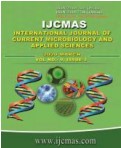


 National Academy of Agricultural Sciences (NAAS)
National Academy of Agricultural Sciences (NAAS)

|
PRINT ISSN : 2319-7692
Online ISSN : 2319-7706 Issues : 12 per year Publisher : Excellent Publishers Email : editorijcmas@gmail.com / submit@ijcmas.com Editor-in-chief: Dr.M.Prakash Index Copernicus ICV 2018: 95.39 NAAS RATING 2020: 5.38 |
In the present fast growing rapidly changing global society, attaining good health has become a challenge for all age groups. Now a day’s consumption of foods made from the leaves increased, but still, few are considered as wastes, but they are actually beneficial for health. The study was made to utilize mulberry leaves in different form in value-added product, thus reducing the wastage and providing inexpensive, healthy product. Mulberry leaves contain a good amount of high protein, vitamin C, beta-carotene and calcium contents. It can be easily grown in different parts of India and hence can help to meet the recommended dietary allowance of various micronutrients and improve the health status of vulnerable groups. Four variations of mulberry leaves masala biscuit were developed using mulberry leaves in different proportions viz., 2.5, 5, 7.5, 10 per cent in preparation of masala biscuit with other commonly used ingredients. The acceptability of four variations of developed mulberry leaves masala biscuit were studied by evaluating different organoleptic characteristics by 21 semi trained panel member. Mulberry leaves masala biscuit proportion 7.5 per cent secured highest acceptability scores. Further proportion 3 was subjected for nutrient and cost analysis.
 |
 |
 |
 |
 |